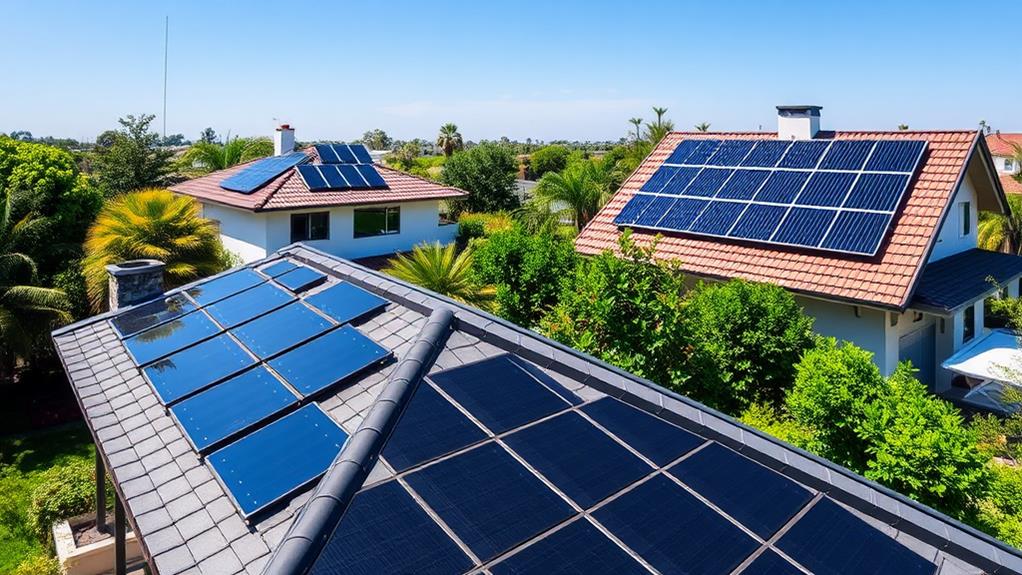Selecting the top solar energy prediction tools is essential for achieving accurate insights and optimizing our solar project efficiency. Notable tools include SolarAnywhere, which offers site-specific predictions with 1-minute resolution and 99.99% uptime; Solcast, generating over 600 million forecasts hourly; and Hymate, which utilizes advanced analytics for superior PV system performance. These tools utilize machine learning and satellite imagery, providing high accuracy and real-time data access. Additionally, seamless integration with existing systems enhances operational capabilities. By understanding their features and benefits, we can more effectively manage solar resources and mitigate risks associated with weather events. More information awaits.
Key Takeaways
- SolarAnywhere offers site-specific forecasts with 1-minute resolution and an impressive 99.99% uptime for reliable solar data.
- Solcast utilizes satellite imagery to generate over 600 million forecasts hourly, enhancing operational efficiency in solar energy prediction.
- Hymate employs advanced analytics for exceptional forecasting accuracy, optimizing performance assessments of photovoltaic systems.
- Ivy Energy Virtual Grid integrates AI-driven alerts for improved community energy distribution and management.
- Power FactorsDrive focuses on efficient data handling, providing actionable insights for better decision-making in solar project management.
Key Features of Prediction Tools
When it comes to solar energy prediction tools, we can't overlook the key features that set them apart. These tools stand out due to their highly accurate solar forecasting capabilities, utilizing advanced methodologies like machine learning and satellite imagery. With spatial resolutions of 250 meters and temporal updates every minute or 15 minutes, they provide real-time data services that enhance accuracy and consistency. Furthermore, robust API access allows seamless integration into existing systems, optimizing operational efficiency for users. Independent validation studies have ranked tools like SolarAnywhere highly for their reliability, while historical archives of nearly 20 years of typical meteorological year (TMY) data offer invaluable context for understanding past performance, ultimately informing future predictions.
Benefits of Accurate Solar Forecasting
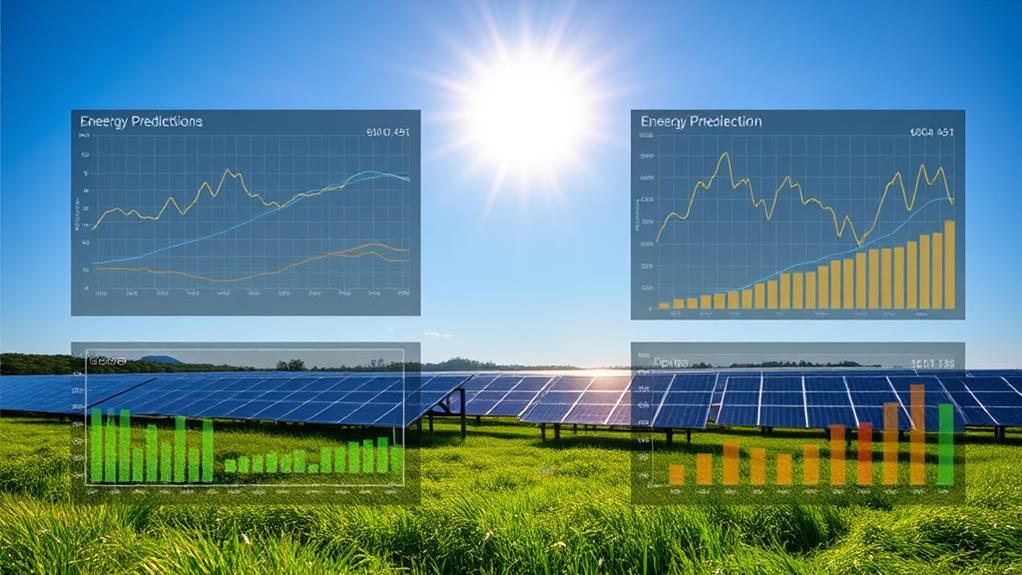
Accurate solar forecasting plays a pivotal role in enhancing operational efficiency and improving asset valuation within the solar energy sector. By leveraging real-time performance monitoring and precise weather data, we can optimize decision-making processes, thereby maximizing energy production and minimizing operational risks. As we explore the benefits of these forecasting tools, it becomes clear that they are instrumental in maintaining compliance with Power Purchase Agreements (PPAs) and ensuring the profitability of solar projects.
Enhanced Operational Efficiency
In the domain of solar energy production, the benefits of precise forecasting can't be overstated; it plays an essential role in enhancing operational efficiency. By utilizing accurate solar forecasting, we can prevent energy imbalances and mitigate operational risks, allowing solar energy producers to meet demand seamlessly. Independent power producers (IPPs) gain significant advantages through precise solar output predictions, which facilitate the intelligent operation of Distributed Energy Resources (DERs) and adherence to Power Purchase Agreement (PPA) requirements. With tools like SolarAnywhere providing long-term solar weather data, we can make informed resource assessments, optimize project locations, and reduce risks. Ultimately, accurate forecasting empowers us to maximize performance and operational effectiveness across our solar projects, leading to more successful outcomes and sustainable practices.
Improved Asset Valuation
With enhanced operational efficiency as a foundation, we can see how accurate solar forecasting greatly improves asset valuation. By leveraging precise weather data, we can optimize energy production assessments, which is essential for determining the true value of solar assets. Companies like Cypress Creek Renewables highlight that accurate solar forecasting allows for better operational decisions, ultimately maximizing the financial potential of solar portfolios. Hymate's forecasting tools provide unmatched accuracy, enabling improved financial planning and investment strategies. With real-time data access, we can swiftly respond to changing weather conditions, mitigating risks that may affect asset performance. This confluence of accurate forecasting and detailed weather data not only enhances operational efficiency but also solidifies the financial health of our solar investments, ensuring long-term sustainability.
Real-Time Performance Monitoring
Real-time performance monitoring is vital for enhancing solar energy systems, and it heavily relies on precise forecasting. By utilizing accurate solar forecasting, we can effectively manage energy projects, ensuring that we avoid energy imbalances and mitigate operational risks related to short-term power sourcing. The SolarAnywhere forecasting service, with its impressive 99.99% uptime, provides reliable solar data essential for informed decision-making. Additionally, site-specific forecasts with 1-minute resolution enable ideal battery utilization, enhancing overall performance. For independent power producers, precise solar output predictions not only support compliance with Power Purchase Agreement (PPA) requirements but also greatly boost project profitability. Continuous advancements in solar irradiance data and annual Solar Risk Assessment reports also improve the accuracy and reliability of these predictive tools in our industry.
Overview of Leading Tools

In our exploration of leading solar energy prediction tools, we'll examine their key features and capabilities to understand how they enhance forecasting accuracy and operational efficiency. Tools like SolarAnywhere and Solcast stand out for their advanced algorithms and real-time data access, while Hymate and Ivy Energy Virtual Grid leverage AI-driven insights for optimal asset management. By comparing these tools, we can identify which solutions best meet specific user needs and project requirements in the rapidly evolving solar industry.
Key Features Overview
Precision in solar energy forecasting is essential for maximizing efficiency and performance in renewable energy management. Leading tools like SolarAnywhere provide site-specific forecasts with a remarkable 1-minute resolution, ensuring unparalleled accuracy in energy management. Solcast enhances solar performance assessments through its robust API, generating over 600 million forecasts hourly by utilizing satellite imagery and machine learning. Hymate stands out for its unmatched accuracy, leveraging advanced data analytics to optimize PV systems and reduce operational risks. Cypress Creek Renewables employs precise solar forecasting to maximize asset value, integrating accurate weather data into performance assessments. Ultimately, Power FactorsDrive offers a cloud-based asset performance management tool that streamlines workflows, supporting the monitoring and optimization of renewable energy assets, thereby enhancing operational efficiency.
Comparison of Capabilities
When comparing the capabilities of leading solar energy prediction tools, we find that each offers unique strengths tailored to specific needs in the renewable energy sector. SolarAnywhere ranks highest in accuracy, providing site-specific forecasts at a 1-minute resolution, ideal for complying with utility Power Purchase Agreements. Solcast excels in operational efficiency, utilizing satellite imagery and machine learning to generate over 600 million forecasts hourly, ensuring precise weather data. Hymate stands out for its unmatched accuracy in solar forecasting, effectively enhancing performance assessment. In contrast, Ivy Energy Virtual Grid focuses on multi-unit community distribution, integrating AI-driven alerts for reduced costs. Finally, Power FactorsDrive automates workflows for monitoring and optimizing renewable assets, emphasizing efficient data handling and actionable insights.
Integration With Existing Systems
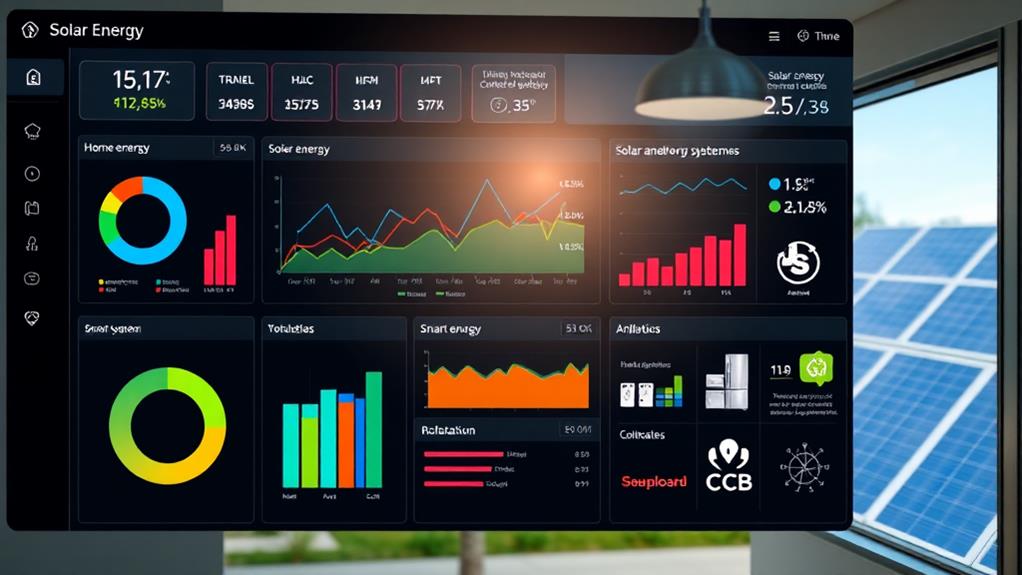
Seamless integration is essential for maximizing the potential of solar energy prediction tools. By utilizing leading software solutions like SolarAnywhere, we can easily connect via API, SFTP, or automated email delivery, ensuring our existing operational systems work in harmony. Tools such as Helioscope and Aurora Solar elevate our project management capabilities by integrating with CRM software like Salesforce and HubSpot, enhancing our sales processes. Additionally, the Solar Data Systems SolarMaaS platform offers robust asset management solutions that can seamlessly integrate with monitoring systems, boosting operational efficiency. These integration capabilities support automated workflows, drastically reducing human error while streamlining data retrieval for real-time forecasting. With extensive API documentation, users can effectively enhance data accuracy and overall operational performance.
Data Types for Solar Prediction
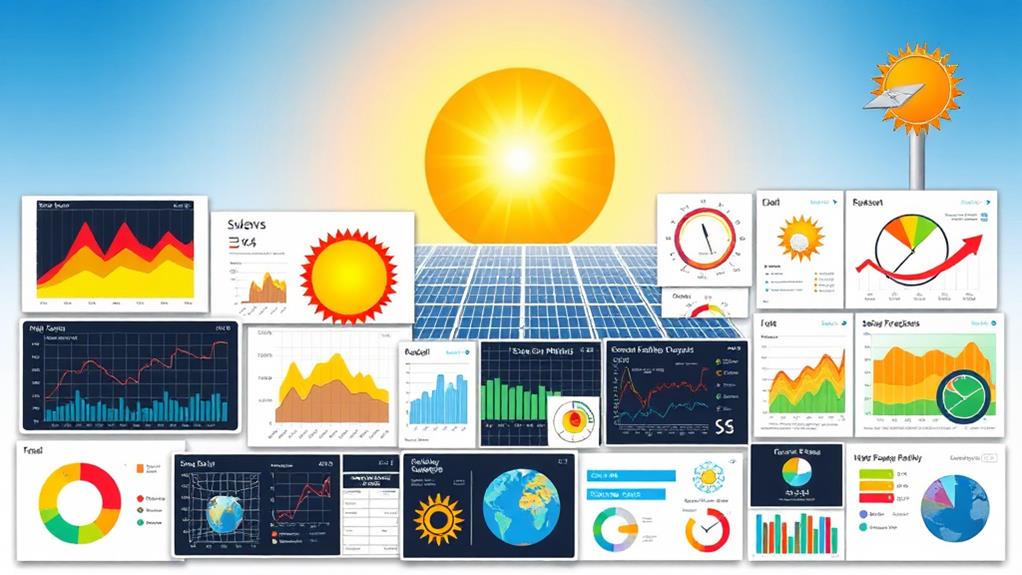
Understanding the various data types for solar prediction helps us make informed decisions about our energy projects. These data types are vital for optimizing performance and maximizing our freedom in energy management:
- Historical data reveals past solar performance trends, allowing us to anticipate future generation.
- TMY files provide standardized weather data, enabling consistent comparisons across locations.
- Live data gives us real-time insights into current conditions, essential for immediate decision-making.
Moreover, forecast data, generated through advanced weather models, predicts future solar performance, aiding in energy trading and grid management. Finally, we must rely on validation and accuracy metrics to guarantee the reliability of our predictions, enhancing our confidence in operational strategies and facilitating effective energy solutions.
Impact of Weather Events

Weather events can have a profound impact on solar energy production, and we need to be aware of these effects to optimize our energy strategies. For instance, Storm Boris released severe flooding in Central Europe, drastically reducing solar output, while the first snowfalls in the UK and Alpine regions covered panels, further hindering energy generation. Typhoon Yagi also led to significant drops in solar production across Southeast Asia, affecting cities like Hanoi and Shenzhen. Accurate forecasting tools become essential in these scenarios, as they rely on key metrics such as cloud cover and cloud opacity to predict potential impacts on our solar resources. By incorporating shading analysis into our strategies, we can better manage the risks associated with unexpected weather events.
Real-Time Monitoring Capabilities
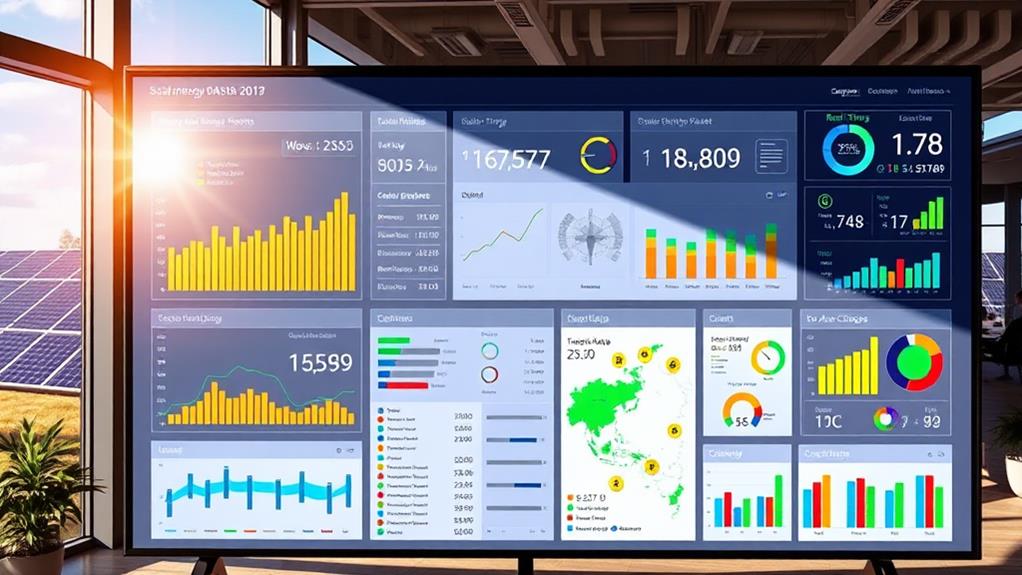
While unexpected weather events can disrupt solar energy production, real-time monitoring capabilities are transforming how we manage these challenges. With solar forecasting tools generating over 600 million forecasts hourly, we gain immediate access to solar conditions that enhance our operational efficiency.
- Site-specific forecasts with a resolution of 1 minute optimize battery utilization.
- Cloud-based solutions guarantee 99.99% uptime, allowing consistent access to critical data.
- APIs enable seamless integration of live monitoring into our operational workflows.
These advancements in real-time monitoring empower us to make informed decisions, leading to effective energy assessment. By leveraging these technologies, we can embrace the freedom that comes with reliable and accurate insights into our solar energy systems, assuring robust performance while minimizing disruptions.
Case Studies and Success Stories

As we explore the impact of solar energy prediction tools, it's clear that real-world applications have yielded impressive results across various sectors. For instance, Invenergy Services has harnessed SolarAnywhere's satellite-generated data to enhance their solar project assessments, greatly improving operational efficiency. GivePower successfully utilized the tool to design cost-effective Solar Water Farms, showcasing its versatility in the solar industry. National Grid Renewables developed a substantial 5 GW portfolio by integrating SolarAnywhere API for precise solar resource data, facilitating accurate forecasting. Lightsource BP relied on SolarAnywhere for detailed project evaluations, essential for securing investments. Additionally, Nexamp values its scalability and bankability, which supports their growth and effective project management strategies, ensuring design accuracy and maximizing solar power potential.
Frequently Asked Questions
What Metrics for Evaluating the Accuracy of Solar Power Forecasting?
When evaluating solar power forecasting, we consider various metrics like error analysis, performance benchmarks, and forecasting models. Utilizing diverse data sources enhances our predictions, enabling better user applications and ultimately supporting our quest for energy independence.
How Do You Predict Solar Energy Production?
As the saying goes, "knowledge is power." We predict solar energy production by analyzing solar panel efficiency, considering weather impacts, energy storage solutions, and grid integration, all while staying in tune with renewable energy policies for freedom in sustainability.
What Machine Learning Algorithms Are Used for Solar Power Prediction?
When we look at solar power prediction, we often use time series analysis, neural networks, regression models, and support vector machines. Ensemble methods can really enhance our forecasts, giving us the freedom to innovate further.
What Are the Methods of Solar Forecasting?
When it comes to solar forecasting, we harness weather patterns and data sources, using advanced forecasting techniques and energy models to predict solar radiation. Together, we can embrace a brighter, more sustainable future powered by the sun.







